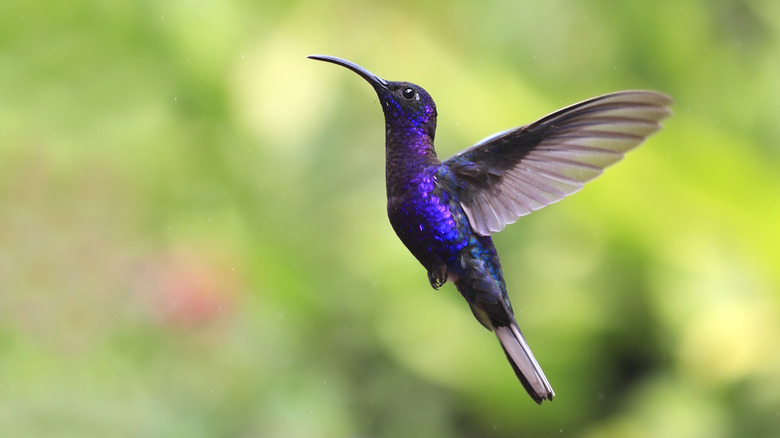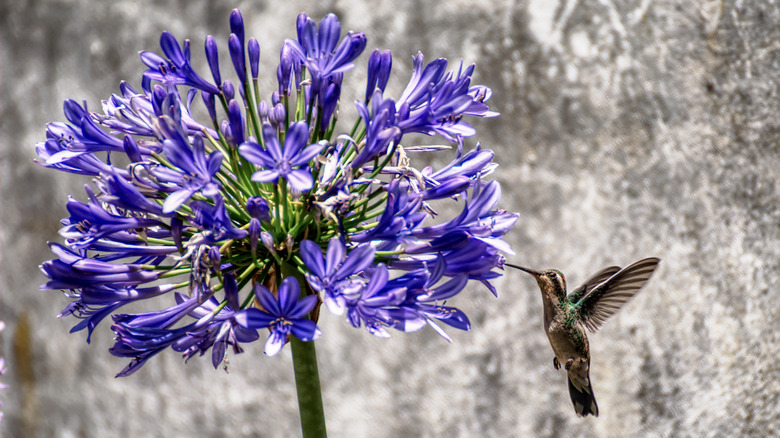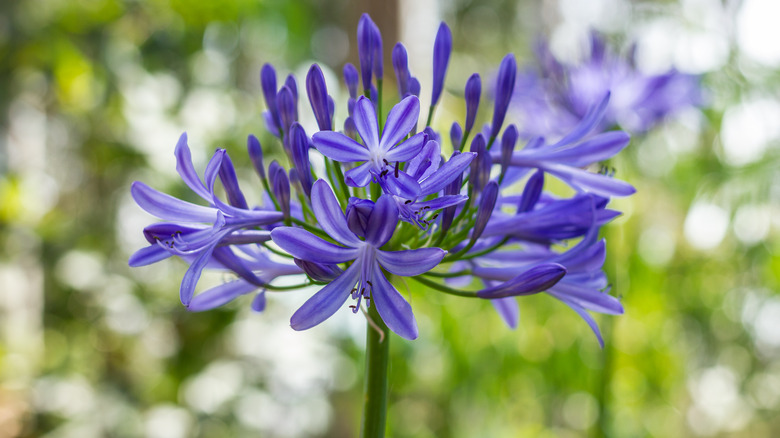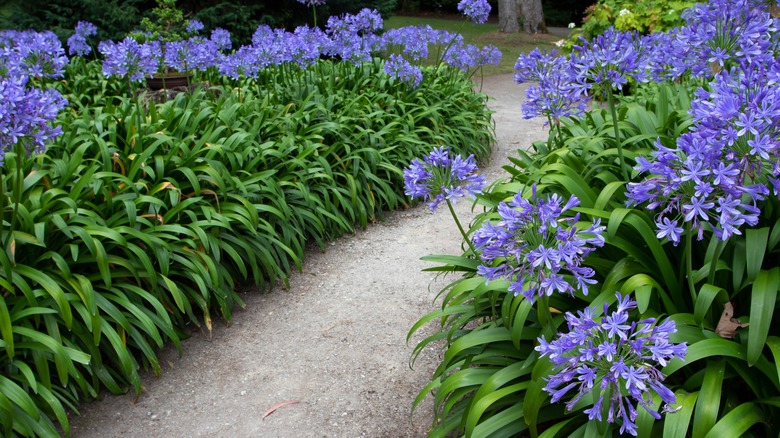Lure Hummingbirds To Your Yard With A Bright Blue Flower They Can't Resist
Although they may only be a few inches long, hummingbirds make a big difference in our gardens. These nectar-loving birds pollinate many plants, some of which rely on their distinctive feeding method for successful pollination. We can help support this bird species by creating hummingbird-friendly yards that help them meet their needs. Providing vibrant, tubular flowers for them to drink from is one of the best ways to attract hummingbirds to your garden. With several hummingbird-favorite qualities, 'Ever Sapphire' Agapanthus (Agapanthus hybrid 'ANDbin' PP26336), also known as Lily of the Nile, is the perfect stunning blue flower you should grow in your garden if you want to lure in your favorite backyard beauties.
Agapanthus is a prolific bloomer, gracing our gardens with its vibrant blue blooms atop 12- to 24-inch flower stocks from spring through summer. Not only are they easy to grow, but they're pest and disease-resistant, making them suitable for beginner and expert gardeners alike. These plants grow quickly, and once established, they're drought-tolerant, only needing watering during dry periods. Hardy in USDA zones 7 through 11, this Southern Africa native adapts well to many climates. Their blooms look amazing in rock, coastal, and cottage gardens and can thrive in beds or containers. While your animal and insect guests may enjoy looking at the pretty bursts of sapphire in your yard, pollinators will especially love paying a visit to enjoy the sweet nectar. Hummingbirds especially can't resist 'Ever Sapphire' flowers.
Why hummingbirds love Agapanthus
Hummingbirds are fascinating creatures with a lot of unique characteristics aside from their rapid wing movements and hovering abilities. When we see them stick their bills inside of a feeder or flower, it may seem like they're slurping the nectar like a straw. In actuality, the tiny birds drink by inserting their forked tongues into the flower, allowing the hairlike lamellae to grab hold of it before bringing the liquid back into their mouths. 'Ever Sapphire' Agapanthus is perfect for attracting these flying jewels because the vibrant color grabs their attention while the trumpet-shape blooms accommodate their unique beaks.
If you've ever watched hummingbirds, it's likely you've noticed how quickly they flit around your yard. Sometimes, it seems like they're spending all day buzzing from flower to flower, and that's actually relatively true. They must constantly refuel to manage their high metabolisms, so it takes lots of food to keep them going. The clump-forming Agapanthus is a perfect food source, producing several flower stocks in each plant, with 20 to 100 flowers in each umbel. Additionally, its long blooming period means 'Ever Sapphire' is available more than many other flower species, beginning in the spring and reblooming several times throughout the season. Hummingbirds have impressive memories and can even remember locations they've eaten at before. So adding these blue-purple beauties — along with other flowers hummingbirds love — could make your garden their go-to spot to fuel up.
Optimal growing conditions for 'Ever Sapphire' Agapanthus
'Ever Sapphire' might be low-maintenance and fast-growing, but that doesn't mean this flower doesn't have its preferences. Most sites work well for planting this flower, as it has no pH preference and can tolerate dry, clay, loamy, and sandy soils. However, it's happiest when growing from nutrient-rich soils with good drainage. There isn't much this hardy plant can't tolerate, and that includes shade, especially in hotter climates. Generally, however, they thrive when receiving at least six hours of daily sunlight. Young plants will need regular watering until established. However, once your flowers reach adulthood, they can withstand periods of drought.
Agapanthus has a clump-forming habit, so it can easily fill up a garden bed over time, providing even more nectar for pollinators like hummingbirds. Because of this, you'll need to divide your 'Ever Sapphire' at least every three to four years in the spring. In containers, this variety enjoys being plant-bound, so hold off on dividing until the roots have filled the pot. Since they're moderate feeders, you'll only need to lightly fertilize your 'Ever Sapphire' plants during the growing season. Because these plants go dormant in the winter, pause watering during cooler months to allow them to dry out. When grown completely indoors, only water monthly in the winter. In areas that get below 55 degrees Fahrenheit, add a few inches of mulch to provide extra insulation when temperatures dip. You may also move potted plants indoors to overwinter.
Creating a hummingbird-friendly garden with 'Ever Sapphire' Agapanthus
To grow 'Ever Sapphire' Agapanthus in your garden, water the soil where you plan to plant the bulbs. Then remove about an inch of soil to make room for the bulb root before covering it up with dirt. Give the soil another watering and keep the soil moist until it's established. If you plant in a garden bed, give your plants about 1 to 2 feet of space between one another. Doing so gives them plenty of room to spread out while rewarding you with a lush, full bed. This semi-dwarf cultivar's clumping habit will keep it from dominating your garden, so it also looks beautiful in mixed plantings. (If you live in Australia, though, Agapanthus is considered an invasive species, and only near-sterile plants should be planted.)
To enjoy all the benefits of attracting hummingbirds to your yard, pair 'Ever Sapphire' with companion plants. Flowers like butterfly weed (Asclepias tuberosa), red hot poker (Kniphofia 'Alcazar'), and Crocosmia 'Lucifer' (Montbretia) are all like magnets to hummingbirds. To make your yard an even more nutrient-dense spot for hummers, avoid using pesticides. Although these small birds drink a lot of nectar, they also enjoy snacking on insects, so it's good to keep some around. Lastly, these adorable creatures nest close to where they feed, so adding small deciduous shrubs or trees near your Lilies of the Nile will be the final puzzle piece to make the area a perfect home for hummingbirds.



